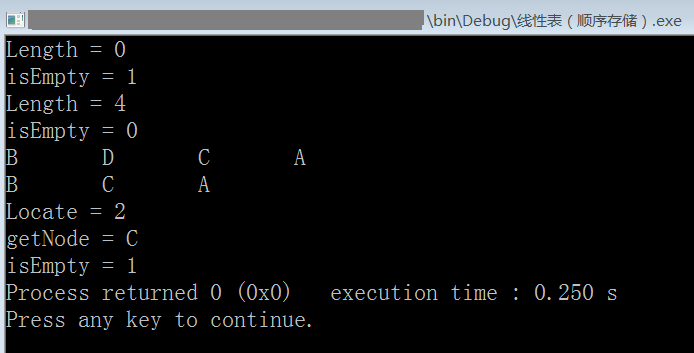1 #include <stdio.h> 2 #include <stdlib.h> 3 4 #define OK 1 5 #define ERR 2 6 #define TRUE 1 7 #define FALSE 0 8 #define MAXSIZE 20 //定义线性表的最大长度 9 10 typedef int status; //定义函数返回的状态,OK & ERR 11 typedef char datatype; //定义线性表中每个结点的数据类型,这里暂定为字符型 12 13 typedef struct { 14 datatype data[MAXSIZE]; //存储着线性表中的每个结点 15 int length; //线性表当前的长度 16 } SequenceList; 17 18 /* 函数原型,线性表的基本操作 */ 19 SequenceList *createSequenceList(void); 20 status isEmpty(SequenceList *L); 21 void clear(SequenceList *L); 22 int getLength(SequenceList *L); 23 int locateNode(SequenceList *L,datatype node_to_locate); 24 datatype getNode(SequenceList *L, int index); 25 status insert(SequenceList *L, int index, datatype node_to_insert); 26 status delete(SequenceList *L, int index); 27 void showList(SequenceList *L); 28 29 int main(){ 30 /* 测试 */ 31 SequenceList *root; //指向线性表 32 root=createSequenceList(); //创建一个线性表 33 printf("Length = %d ",getLength(root)); //打印线性表的当前长度 34 printf("isEmpty = %d ",isEmpty(root)); //打印线性表是否为空 35 insert(root,0,'A'); //分别插入4个结点 36 insert(root,0,'B'); 37 insert(root,1,'C'); 38 insert(root,1,'D'); 39 printf("Length = %d ",getLength(root)); 40 printf("isEmpty = %d ",isEmpty(root)); 41 showList(root); //打印线性表 42 putchar(' '); 43 delete(root,1); //删除index=1(数组下标为1)的结点 44 showList(root); 45 putchar(' '); 46 printf("Locate = %d ",locateNode(root,'A')); //打印查找到的结点的位置 47 printf("getNode = %c ",getNode(root,1)); //打印下标是1的结点的值 48 clear(root); //清空线性表 49 printf("isEmpty = %d",isEmpty(root)); 50 51 return 0; 52 } 53 54 SequenceList *createSequenceList(void){ 55 SequenceList *tmp; 56 tmp=malloc(sizeof(SequenceList));//void*类型指针能自动转为其他类型的指针 57 tmp->length=0; //初始化线性表长度 58 return tmp; 59 } 60 status isEmpty(SequenceList *L){ 61 if (L->length==0) 62 return TRUE; 63 else 64 return FALSE; 65 } 66 void clear(SequenceList *L){ 67 L->length=0; 68 } 69 int getLength(SequenceList *L){ 70 return L->length; 71 } 72 int locateNode(SequenceList *L, datatype node_to_locate){ 73 //返回找到的结点的index 74 //node_to_locate应当是能唯一标识一个结点的数据,否则只返回匹配的第一个结点 75 int i; 76 for (i=0; i<L->length; i++){ 77 if (L->data[i]==node_to_locate) 78 return i; 79 } 80 return -1; //未找到任何匹配 81 } 82 datatype getNode(SequenceList *L, int index){ 83 //index表示线性表中第N个结点,头结点的index是0 84 if (L->length==0 || index<0 || index>L->length-1) return (datatype)ERR; 85 return L->data[index]; 86 } 87 status insert(SequenceList *L, int index, datatype node_to_insert){ 88 //node_to_insert表示想要插入的结点 89 //当列表为空时,只有index=0才能插入 90 int k; 91 if (L->length == MAXSIZE) return ERR; //线性表已满 92 if (index<0 || index>L->length) return ERR; //index不在有效范围 93 if (index<L->length){ 94 //插入的位置不是最后一个结点的下一个结点 95 for (k=L->length-1; k>=index; k--){ 96 L->data[k+1]=L->data[k]; //将要插入结点后面的所有结点都往后移 97 } 98 } 99 L->data[index]=node_to_insert; //将新结点插入 100 L->length++; 101 return OK; 102 } 103 status delete(SequenceList *L, int index){ 104 int k; 105 if (L->length == 0) return ERR; //线性表为空 106 if (index<0 || index>L->length-1) return ERR; //index不在有效范围 107 if (index<L->length-1){ 108 //删除的位置不是最后一个结点 109 for (k=index; k<L->length-1; k++){ 110 L->data[k]=L->data[k+1]; //将删除位置后面的结点都往前移 111 } 112 } 113 L->length--; 114 return OK; 115 } 116 void showList(SequenceList *L){ 117 int i; 118 for (i=0; i<L->length; i++){ 119 printf("%c ",L->data[i]); 120 } 121 } 122 123 /* 124 顺序存储结构的线性表的优缺点: 125 优点: 126 1.不必为每个结点之间的逻辑关系增加额外的存储空间 127 2.可以快速地读和写表中任意一个结点 128 缺点: 129 1.插入和删除需要移动大量结点 130 2.线性表动态变化较大,难以确定所需的存储空间 131 3.数组预设过长会造成空间浪费(存储碎片) 132 */ 133 /* 环境: Code::Blocks with GCC 5.1 */
运行截图:
